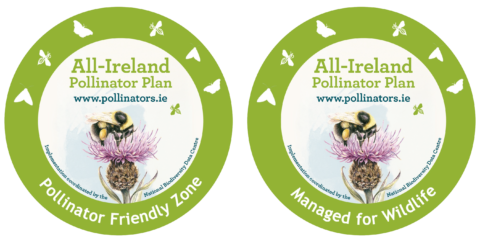Posted In Conservation, Visitors | 17th May 2022
There’s a buzz around Dublin Zoo
Dublin Zoo is buzzing with excitement to announce we are taking part in The All Ireland Pollinator Plan (AIPP) to help save Irish bee species, other pollinating insects and plants across the country. This five year plan aims to encourage a better way of looking after our whole landscape to support our struggling biodiversity in Ireland.
‘Bio-diversity’ means the variety of all the living things in the world. It includes everything from the tiniest insect in your garden to the enormous Asian elephants at Dublin Zoo. It’s so important to protect biodiversity because plants and animals all depend on each other for survival. Bees are super-important pollinators for flowers, fruits and vegetables – which means they spread the pollen from plant to plant to help them grow. Without bees we would be without many types of fruit, vegetables and nuts!
One third of the native bee species in Ireland is sadly at risk of extinction. This is because we have drastically reduced the number of flowers and safe nesting areas in our landscapes. Dublin Zoo is proud to be taking action to help bees survive and thrive in Ireland.
Dublin Zoo’s mission is to protect biodiversity for generations to come. That’s why we partner with conservation projects worldwide and in Ireland, to preserve biodiversity and protect critically endangered species. We are delighted to take action and help the AIPP reach its goals for 2021-2025.
What we are doing
We have done lots around the zoo to keep the bees and other pollinating insects safe and happy. Take a look around the zoo to see if you can find our protected pollinator zones. Each zone is marked with a special AIPP sign.

Here are just some of the things we are doing to help pollinators:
Going wild
Our fantastic Horticulture team were hard at work planting wildflowers in our Wolves in the Woods habitat and in the new red panda habitat in the Himalayan Hills. The team used a beautiful mix of pollinator friendly plants, including Echinacea, Buddleia, Sedum, Rosemary and many more in our flower beds at the Discovery & Learning Centre. All the wildflower seeds are Irish sourced native plant species.
One, two… bee!
This month, our Conservation Officer, Andrew Mooney and members of the Discovery & Learning Department have started taking part in the Flower-Insect Timed Count (FIT Count). FIT Counts are run all over the country and record the abundance of flower-visiting insects over time. This will help us measure just how effective all of our pollinator-friendly actions are. The FIT Counts run once a month between May and September. All of the results will be submitted to the National Biodiversity Data Centre to help track changes in the population of Ireland’s pollinators.
Wild Space and The Meadow
Wild Space in the African Plains and The Meadow beside Family Farm have protected areas for pollinators, where we allow wildlife to flourish. Here we created earth banks, log piles and soil/sand pits for solitary mining bees. We even drilled holes in the trunk of a fallen tree and placed it here – it’s the perfect spot for nesting solitary bees. You might also spot a specially designed bee hotel in The Meadow
Out of sight
There are even more pollinator friendly areas that are out of sight to visitors. These include wildflower beds, no mow zones and soil banks which offer plenty of safe spaces for bees and other pollinating insects to thrive in.
Do try this at home
Why not try creating a Wild Space in your own garden?
Start by trying not to mow your lawn too often or just leave a patch of grass to grow longer – this will help protect the nests in the area. Plant a variety of flowers that bloom throughout the year this will provide food for bees all year round. Insider tip: bees are big fans of the colour purple! Create some colourful water baths so that the butterflies and bees can enjoy a refreshing drink.
Find out how to create your own water bath here:
Find out more about biodiversity:
Find out more about The All Ireland Pollinator Plan here.
Don’t forget to take a look around the zoo to see if you can find our protected pollinator zones during your next visit to Dublin Zoo.
Book your next visit online and save up to 15%.